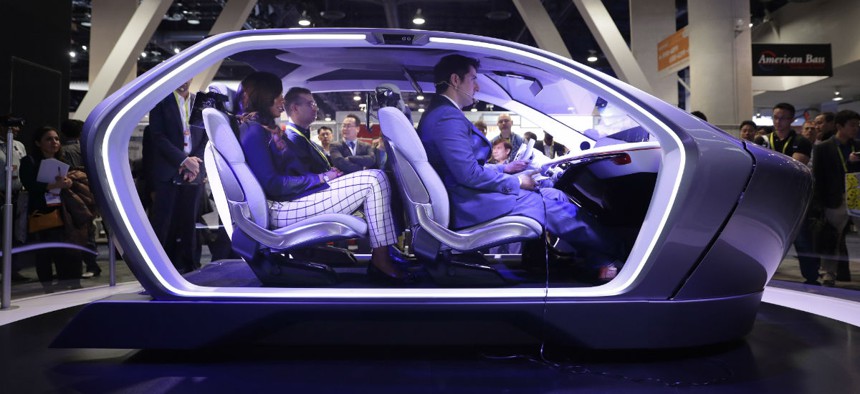Transportation Department Shares Road Map for Self-Driving Cars

how attendees sit in the Chrysler Portal self-driving concept car at CES International Thursday, Jan. 5, 2017, in Las Vegas. Jae C. Hong/AP
Automated driving systems could cut down on fatalities and unlock economic activity, according to the department's recent guidance.
Self-driving cars are the key to drastically reducing traffic fatalities, according to a new safety blueprint from the Transportation Department.
The guidance is designed to encourage the public and private sectors to invest in and develop self-driving and automated driving systems over the next several years. By using sensor systems to prevent drivers from drifting, collision alert systems, and automatic brakes, newer cars could almost eliminate crashes caused by human error, according to the department.
Though the National Highway Traffic Safety Administration encourages drivers to wear seatbelts, avoid driving drunk, and to generally pay attention to safety rules, “people still make those choices and still crash,” the guidance called “A Vision for Safety 2.0” says.
» Get the best federal technology news and ideas delivered right to your inbox. Sign up here.
The Transportation Department also highlighted the potential benefits to people who are unable to drive themselves because of an illness or disability.
NHTSA expects development to happen gradually over the next few years. The majority of cars today require the driver to perform all tasks related to driving though it eventually sees the use of “conditional automation,” which is when cars don't require a driver but one “must be ready to take control of the vehicle at all times with notice,” and fully automated vehicles that don't need drivers at all.
The network of highway safety officials, legislators and technology companies must adjust to promote the development and integration of self-driving cars, the report notes.
In recommendations for highway safety officials, for instance, Transportation recommended states think about “new oversight activities” to ensure that automated driving systems are safe, such as making one specific agency responsible for testing those systems or establishing a formal process for issuing permits for them.
Authors also recommended legislatures regulate only certain areas of self-driving cars. “DOT strongly encourages States to allow DOT alone to regulate the safety design and performance aspects” of self-driving cars, the report said. “If a State does pursue [automated driving system] performance-related regulations, that State should consult with NHTSA.”
The House of Representatives passed such a measure last week. The Safely Ensuring Lives Future Deployment and Research In Vehicle Evolution Act, or SELF DRIVE Act, would establish that manufacturers should follow design rules set by the federal government and operating regulations set by states. It also would boost the number of vehicles that could be tested on roads to 100,000 in a year.
Some in Washington have been more cautious about self-driving cars, with concerns about how vulnerable vehicles could be to hacking and what kinds of personal information they could store. In March, Sens. Ed Markey, D-Mass., and Richard Blumenthal, D-Conn., reintroduced legislation calling for strict standards on cyber protections for self-driving cars and the Senate Commerce Committee is also working a self-driving car legislation that would include a bug disclosure program.





